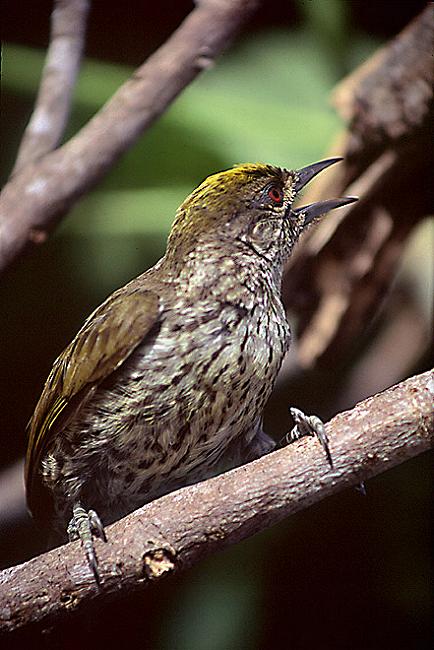
BIRDWATCHING IN THE SOUTHWEST REGION of the DOMINICAN REPUBLIC
Sierra de Bahoruco, Lago Oviedo y Lago Enriquillo
Tambien, pistas para observar aves: los mejores lugares, rutas, dónde comer, acampar, hoteles, etc.
Also tips for bird watching: best locations, routes, places to stay, eat, camp, hotels, etc.
Prepared by / preparado por: Stephen M. & Sandra M. Brauning
UPDATED: April 24, 2007

The Antillean Piculet, a rare endemic woodpecker Nesoctites-micromegas Photo by Miguel Angel Landestoy (Gracias, Mangolandia!)
Known as the "Deep South", this region is by far the best for bird watching in the Dominican Republic.
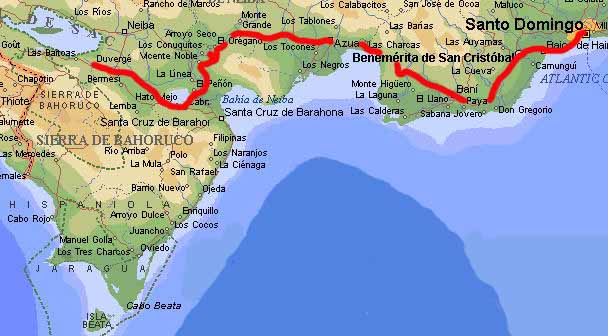
Map #1: Southern DR (The capital, Santo Domingo is at the far right, and the red line shows the highway to Duverge, gateway to the north slope of the Bahoruco range.
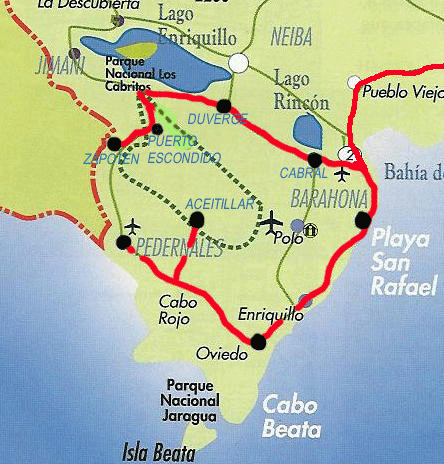
Map #2: The "Deep South" - the red line shows the approx. circle route to cover both slopes of the Barhouco range. The Sierra de Bahoruco national park is outlined with a dark dotted line.(El Sur Profundo)
All of the endemic species(between 28 and 30 -except perhaps the Ridgeway Hawk) and about 18 regional endemics can be found here: the only place in the whole island that is true. Also because of the many diverse habitats, over a hundred other resident and migratory bird species can also be found. BUT... it challenging birding here, because many of the endemics and specialties are very scarce, very skulky, secretive, hard to find with very limited range and habitat(Take a look at the "DR Endemics & Specialties" section on this site). That's why we give the following recommendations:
Here are some contacts: me Steve Brauning(I only guide as a hobby on my vacation time, the others are making a living at it: and they are GOOD. Contact them first if you want to hire a guide.)
Now to get going: here are the most important places to hit on the minimum 4 day trip.
We recommend staying at Villa Barrancoli, a new eco-tourism camping lodge geared for birders, located in Puerto Escondido, on the north slope of the Sierra de Bahoruco.
DIRECTIONS: Travel west from Santo Domingo, past Bani and Azua, almost to Barahona, then take the highway heading west through Cabral, to the town of Duverge (pronounced in Spanish "doo-ver-HEY"). About half way though town, look for the yellow and green "Parques Nacionales" sign on the right side of the road, indicating "Sierra de Bahoruco"; it's a left turn, otherwise unmarked. Up the steep, gravel road, about 12 kilometers to Puerto Escondido, the landscape is barren, although Broad-billed Todies, Green-tailed Warblers, Flat-billed Vireos, Hisp. Lizard Cuckoos and other spp. can be seen in wooded areas. Also there are Burrowing Owl holes along this road.
At entrance to the town of Puerto Escondido, stop at the National Park office to pay the modest fee: RD$50. per person.
To get to the lodge, turn left at the "T", where there are signs for various locations in the National Park. There is a sign for the "Rabo de Gato" trail (Cat's Tail). About 200 meters after that turn, there is a fork in the road: go right and follow this road over three canals; take the first right turn, where there is another sign. This is on the eastern edge of town, across the river and the dam, right on the "Rabo de Gato" trail, a prime wooded area holding the watershed of the "Las Damas" river. This may be the NUMBER ONE birding location in the entire island. Many endemics, a mix of high and lowland species, and a high bird density. Part of the trail is a private birding sanctuary( still in process). This trail can be hiked at your leisure from the lodge.
Make prior arrangements, with Kate Wallace (see contacts above). She is the owner - operator of the lodge. You can camp there comfortably, on tent platforms, and use the kitchen/dining area, bathrooms, and so forth. A WONDERFUL place. Birds abound right on the grounds. More todies and lizard-cuckoos than you can shake a stick at!
If you can't conceive of camping, you can stay at a hotel in Barahona, but that means starting at about 2AM to get to the prime highland spots in time.
Around the town of Puerto Escondido are cultivated fields, good for White-necked Crows, - seen in the large royal palm trees in this area, easily identified by voice -, Greater Antillean Orioles and Greater Antillean Grackles, Village Weavers, Nutmeg Mannikins, and many other species.
There's another area we named "Warbler Woods", on the north and west side of the main road across from the cultivated area. In Migrant season it's loaded! We've seen many warbler spp, as well as Indigo Buntings there.
Also around the cultivated fields (especially the avocato/mango/papaya plantations west of town) is good night birding, with the North Potoo, Burrowing Owl, Greater Antillean Nightjar, and Barn Owls.
Puerto Escondido is the gateway to the higher elevations of the western Sierra de Bahoruco. Heading west from town, the first location is called "La Placa", called that because of the old National Park sign (and a birdwatching sign). The surrounding thorn and transitional forest is great for many species: Loggerhead Kingbird,
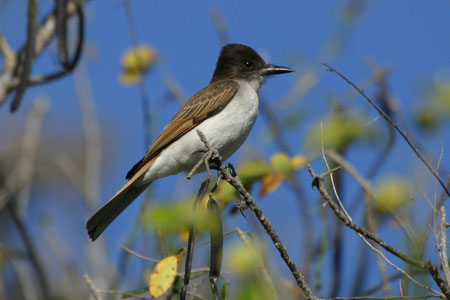
The Loggerhead Kingbird is quite scarce throughout the country, but fairly common in this area. (Photo by Cursorius)
One of the real highlights: the very rare and elusive Bay-breasted Cuckoo.

Photo by Eladio Fernandez
known locally as la "Cúa" because of its call;
(continuing the list from La Placa)-Stolid Flycatcher, Flat-billed Vireo, Key West and Ruddy Quail-Doves,
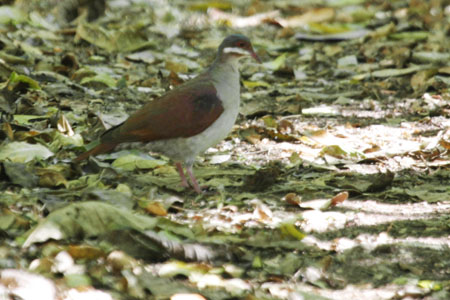
Photo by Cursorius
Olive-throated Parakeets, more Lizard-Cuckoos; Mangrove Cuckoos have been recorded around here; as well as many migratory warblers.

Hooded Warbler, a rare migrant. Another one is the Worm-eating Warbler: a real skulker!
Further up the slope (heading mostly west), the road gets really rough (unpassable, at times due to wash-outs); but the birding just keeps getting better! In an area called Naranjo, you start getting into more moist broadleaf forest. All along are good spots for Hispaniolan Trogons, Greater Antillean Bullfinches, Hisp. Parrots and Parakeets, Antillean Piculets, and so forth.
Stop at wooded clumps, ravines; use the tape for the BB Cuckoo. There is one place dubbed "The Cúa field" (Cúa being the local name for the BB Cuckoo, based on its call). It is an overgrown flat field, bordered by steep slopes, where the bird has been seen on numerous occasiones.
Then you get to Aguacate army base, which is right on the border with Haiti. Check in with the military personnel, explain that you are observing birds ("mirando aves"). Up higher, after numerous switchbacks, you get to Zapoten, the potato market area; (about 25 km from puerto Escondido) this is the prime high-elevation birding area despite the exensive deforestation all around. You are now in pine forest; go past cleared areas, past the next two sharp turns to the left; here is the prime area for Laselle's Thrush and the Western Chat Tanager. Ideally, you would come straight here from camp, arriving just before dawn. It's about the only time to even have a chance at seeing these two birds.
Other highlights here: White-winged Warbler, White-fronted Quail-Dove(split from Gray-headed), Hispaniolan Spindalis, Bicknell's Thrush (in winter), Green-tailed Warbler, Antillean Siskin, the endemic subspecies of the Pine Warbler, Rufous-throated Solitaire, Scaly-naped Pigeon, Antillean Euphonia, Red-tailed Hawk, Sharp-shinned Hawk, Hisp. Pewee, Golden Swallow, Antillean Piculet, Hisp. Emerald, Greater Antillean Eleania, etc.
You can continue up the slope all the way to "Loma de Toro", one of the highest spots in the Bahoruco. Here is where the extremely rare Black-capped Petrel nests in caves in the winter and spring. One could continue over to explore the south Bahoruco slope from here. Makes for a long day, though. It's better to go back down to Puerto Escondido to pick up all the areas listed previously.
To cover the south slope, go all the way past Barahona to Oviedo. Stop at the Oviedo National Park, at the edge of the Lago Oviedo. There's a sign and a National Park building (painted yellow & green). Drive along the track to the left, along the edge of the lake, up to where you can observe the mangroves. Look for flamingos, ducks, spoonbills, waders, egrets and herons. Be careful if the ground is wet, you could get stuck. The endemic Yellow Warbler subspecies is here too: what some call the Hispaniolan Golden Warbler- found in mangroves and adjacent scrub.
Continue towards Pedernales: at the Cabo Rojo highway -also known as the ACLOA road since it was built by that mining company. You go over an overpass - just past this, turn right on the dirt track and then left on the highway. You now head up the mountains into the Sierra de Bahoruco. The National Parks department is fixing it up and putting signs and a gate. At the sharp hairpin curve about where you start to see pine trees, stop to look for Western Chat Tanagers, Scaly-naped Pigeons, Antillean Euphonias, Red-tailed Hawk, Sharp-shinned Hawk, Hisp. Lizard Cuckoos, Hisp. Pewee, etc. About 500 meters ahead where the road curves back to the right and goes straight again, look for Antillean Piculet, Hisp. Emerald, quail-doves, and Olive-throated Parakeets. Continue up until about KM. 28? to the Aceitellar pool, pull in to the right. At the pool and surrounding pine forests is one of the few reliable places for the endemic Hispaniolan Crossbill (Loxia megaplaga)
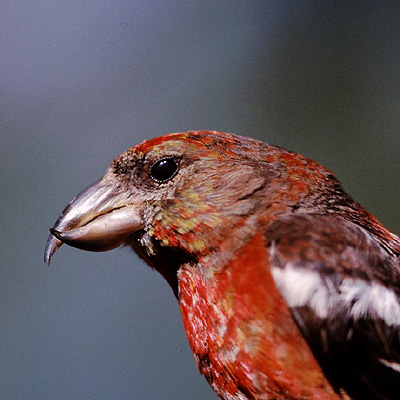
Also, other highland species such as Narrow-billed Tody,

photo by Cursorius
Scaly-naped and Plain Pigeons, Golden Swallow, Hisp. Pine Warbler, Palm Crow, Black-crowed Palm Tanager, Hisp. Parrot and Parakeet, Antillean Siskin, etc. This spot is worth spending some time. At dawn and before dusk, birds gather to drink at the pool.
Farther up is the National Park visitors' center, and once past that, you can explore the trails and roads through the pine forest and old mining areas. It is possible to camp, but you may need special permission for that. Here, you get most of the afore-mentioned highland spp.; in season, there are many migratory warblers; also Hispaniolan Pewees,
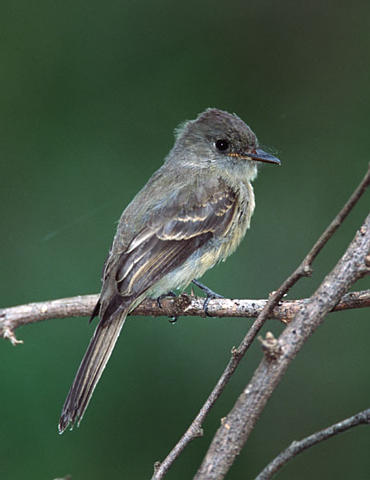 photo by Eladio Fernandez
photo by Eladio Fernandez
Also near here is the very impressive "Hoyo de Pelempito" geological formation - an 8 km2 karstic depression. Also much undisturbed dry and transition montain forest. It's worth a hike even part way down.
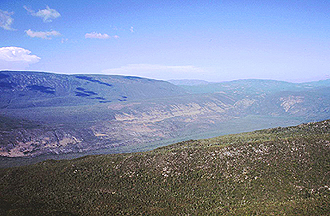
Check out this web page: http://www.kiskeya-alternative.org/publica/eleuterio/natufuerza261099.htm
Whether you camp in the Aceitellar area or not, this is a good area for night birds. Back down the mountain, looking for Antillean Nighthawks and Nightjars, and Least Poorwills. Where there are steep banks, look for Burrowing Owls.
If you are very brave, stay up in the mountains after dark to look for Stygian Owls - very tough to find though.
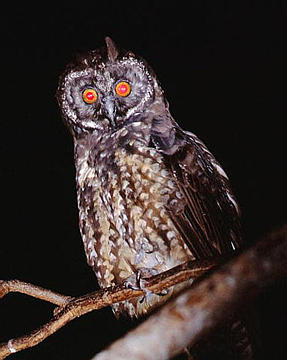
Stygian Owl photo by Eladio Fernandez
Back at the main highway, head right (west) towards Pedernales. In town, check in at Mary Federales Pension(one block to the left - there's a sign), or head to her restaurant - turn right at the "telephone" symbol, go about 4 blocks and turn left: if lost, ask locals. This restautant offers wonderful seafood and other meals. Call ahead if you want - 809-524-0231, ask for Mary. You can stay in another hotel: Costa Caribe hotel, Fundacipe, or Don Fransiscos(809-524-0106).
For coastal birding, Cabo Rojo is the place. There are wetlands along the highway towards Pedernales, too. At the Cabo Rojo crossroads, go south towards to ocean. Check out the pools on the sides(shorebirds, ducks, waders), then the mangroves and beaches(Yellow Warbler) on the right. If you are brave enough, head towards Bajia de Las Aguilas(very rough road -White-tailed Tropicbirds, Brown Boobies).
To really cover the South slope of the Sierra de Bahoruco, you have to go up(north) from Pedernales. It's a long drive no matter where you start, even Pedernales: leave about 4:30AM from there to ge to the highland at dawn. The road heads straight north, winding up the mountains through ravines, farm land, ridges, etc. Once you get up a ways, there are THREE LEFT TURNS: one is marked with a sign for the National Park (about 10 KM from Pedernales?), the next one is not marked at all except for a sign about the water project and the left turn goes downhill (counter-intuitive that it’s the correct way to go), and the third left is up in the agricultural fields out in the open.
About 27 km from Pedernales is an area called "Los Arrollos" where there is an army border post (you are very close to Haitian border right here) and some fragmented habitat, but rich with bird life. Eventually you get up to end of the cultivated fields (watch for Antillean Nightjars, Northern Potoos, Ashy-faced and & Barn Owls along the road before dawn), and into a forest area. The road tends to be very rough. A few hundred yards after the woods start there is a wide place on the road; park. Then there is a trail on the right, with a tree marked #2050 with red paint. It may be hard to find: just watch closely through the wooded sections where there is good habitat. Walk this trail - look for LeSelle's Thrush, Western Chat Tanager, Hisp. Trogon, Rufous-throated Solitaire, Narrow-billed Tody, White-winged Warbler and Green-tailed Warbler. Playback may facilitate observation. Some of these birds can be seen along the road as well.
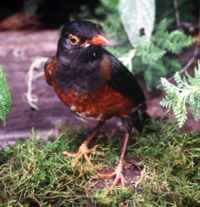
The LeSelle's Thrush is a rare and elusive endemic.
Many migratory birds are also seen here: look for mixed flocks. This is a prime location, worth spending the morning.
You can return to Puerto Escondido, up and over the mountains, or return and stay in Barahona at one of the hotels such as Hotel Caribe, mostly along the waterfront. There are other cheaper hotels in town.
Also on the south slope, at the eastern extreme, is the community conservation project of Cachote. There are cabins in the cloud forest; many of the highland species including, surprisingly, the Eastern Chat Tanager recently identified there. A newpaper article: http://www.diariolibre.com/app/article.aspx?id=76526
There is a local birding guide in Barahona, Julio Feliz, who can help you find the endemics and other interesting spp. Find Julio at the Guaracuya hotel, ask at the desk or call 809-524-6570.
Another important area to cover in the Southwest is Lago Enriquillo, a hyper-saline lake, the largest inland body of water in the Caribbean. It can be circled by car along good roads. On the southern side of the lake, there is an old road that cuts off the main highway just west of Baitoa at a curve(15 minutes west of Duverge). Just stay on the old road bed: the sand can be like quicksand. Palm Crows are reliable there. On the north side of the lake, stop at Agua Azufrada to get to Isla Cabritos on an official National Park boat - well worth it. On the island, Gr. Antillean Orioles and Palm Crows abound. Endemic subspecies of the American Crocodile and the two endemic iguana species are found on the island and along the shore. As you circle and explore the lake and island, look for flamingos, -
(Photo by Alejandro Sanchez) spoonbills, Reddish and other Egrets, Royal, Caspian, Gull-billed, and Black Terns, Snowy Plovers, Laughing Gulls, and other birds; several "Balnearios"(swimming holes with mineral springs) along the edge of the lake are nice for refreshing dips in this hot climate which is at about 40 meters below sea level.
At the western end of the lake is the border town of Jimaní; right at the border is a lake, one of the few reliable places for Caribbean Coots.
That about covers the region, unless you have a few more days and are adventuresome. The Sierra de Neiba offers more highland birding; there are salt flats at Puerto Alejandro east of Barahona; the coffee region of Polo; Laguna Cabral, where local fishermen will take you out on a boat to see ducks, coots, etc.; or any number of other interesting areas. Now if you are REALLY adventuresome, get a local fisherman in Pedernales or Cabo Rojo to take you out to Isla Beata, Alto Velo, and even Los Frailes. It's a trip that takes several hour in motorboat(look for one with a good sized motor like at least a 40hp or you'll never make it in a day), and deserves several hours of treking at least on Beata. The Pearly-eyed Thrasher is found here, and an endemic resident sub-species of the Green-tailed Warbler. On the other islands, Brown Boobies and maybe other rare seabirds can be found.
WHATEVER YOU DO.... If you are going to bird Hispaniola, don't miss this part of the country.
Click here for an Excel format checklist
that you can print out and use.
Click here for a bird finding guide(also Excel).
Return to Table of Contents
Last Updated April 24, 2007 by Steve Brauning
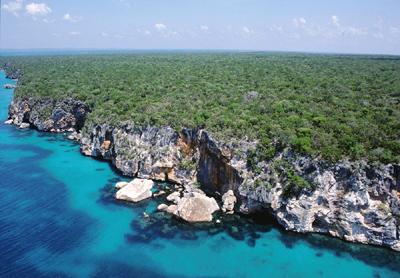
BIRD LISTS FOR THE SOUTHWEST REGION of the DOMINICAN REPUBLIC